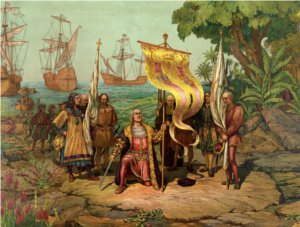
Christopher Columbus and three ships- the Nina, the Pinta, and the Santa Maria set sail on August 3, 1492. He first sailed to the Canary Islands where he reprovisioned and made repairs. On September 6, he sailed west again. After they were 29 days out of sight of land, the crew spotted birds flying west and changed direction to follow them. Then at 2 am on October 12, a lookout cried out that he had sighted land. The crew set foot on an island that day and Columbus named it San Salvador, although the natives called it Guanahani.
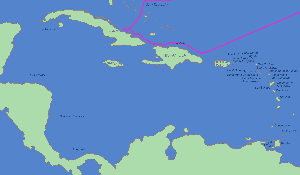
The Native Americans inhabiting the islands were described as "Indians" by Columbus, who believed that he had discovered Asia. In reality, he had found an island in the Caribbean. The natives Columbus encountered were peaceful and friendly. In his logs he wrote in awe of their friendly innocence and beauty. "These people have no religious beliefs and they don't worship idols. They are very gentle and do not know what evil is. They do not kill others or steal. They have no weapons." No blood was shed on this first voyage, however the indigenous islanders began to succumb to unfamiliar European diseases like smallpox, for which they had no immunity. On this first voyage, Columbus also explored the northeast coast of Cuba and the northern coast of Hispaniola. It was here that the Santa Maria ran aground and had to be abandoned. Using the lumber of the shipwreck, Columbus built a settlement here and left 39 men. On January 4, 1493, he set sail for home.
As he approached the Azores, he ran into one of the worst storms of the century. Astoundingly, both the Nina and the Pinta were spared. Leaving the island of Santa Maria in the Azores, Columbus first landed in Portugal, and word of his discoveries spread rapidly throughout Europe. When he finally arrived in Spain, he was received as a hero. This was his greatest moment. He displayed to the court several kidnapped natives and what gold he had found, as well as the previously unknown tobacco plant, the pineapple fruit, the turkey and the hammock.
A Round Earth
Contrary to popular belief, most people in the 15th century knew the world was round. This was especially true for sailors, explorers and navigators. There was still, however, uncertainty regarding the world's size and circumference. Columbus greatly underestimated the size of the world. When trying to finance his expedition, he first approached the court of Portugal. He was rejected, in part because the king's experts, who had a fairly accurate idea of the world's size, doubted that anyone could survive the 19,600 km (10,600 nautical miles) trip from Europe to East Asia.
After the Portuguese rejection, Columbus tried to get backing from the Spanish monarchs: Ferdinand of Aragon and Isabella I of Castile. By marrying, Ferdinand and Isabella had united the largest kingdoms of Spain and were ruling them together. Columbus spent the next 7 years lobbying the Spanish court, and in 1492 was finally successful. The monarchs agreed to help finance the expedition. Because Spain was financially drained from the campaign to conquer Granada, the last Muslim stronghold on the Iberian peninsula, the Royal Treasurer had to shift funds among various royal accounts to get the money for Columbus' enterprise. Only half the money came from Spain. Italian investors had already agreed to provide half the money.
The Second voyage
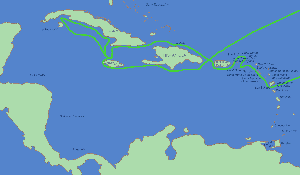
On September 24, 1493, Admiral Columbus left from Cadiz, Spain for his second voyage, with 17 boats carrying supplies, and about 1200 men to assist in the subjugation of the native Americans and the colonization of the region. On November 3, 1493, Columbus sighted a rugged island that he named Dominica. Sailing northwest he discovered and explored more than a dozen Caribbean islands before finally reaching Hispaniola and the site of the settlement he began. There he found that all the colonists had been killed and the fort burned.
Before he left Spain for his second voyage, he had been directed by Ferdinand and Isabella to maintain friendly, even loving, relations with the natives. However, during his second voyage he sent a letter to the monarchs proposing to enslave some of the native peoples, specifically the Caribs, on the grounds of their aggressiveness. Although his petition was refused by the Crown, in February 1495, Columbus captured 1600 Arawak, a peaceful tribe, as slaves. Some of them were shipped to Spain where after legal proceedings, the survivors were released and ordered to be shipped home. Some were kept by Columbus and his men as slaves, while the others were let go. They fled into the hills, making, according to Columbus, prospects for their future capture dim.
Rounding up the slaves led to the first major battle between the Spanish and the Indians in the New World.
The main objective of Columbus' journey had been gold. To further this goal, he imposed a system on natives in Haiti. All those above fourteen years of age had to find a certain quota of gold. Those who failed to reach their quota would have their hands chopped off. Despite such extreme measures, Columbus did not manage to obtain much gold. In his letters to the Spanish King and Queen, Columbus would repeatedly suggest slavery as a way to profit from the new colonies, but these suggestions were all rejected by the monarchs, who preferred to view the natives as future Christians.
The Third Voyage
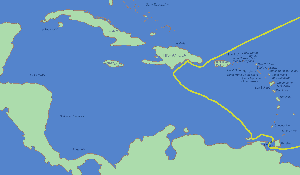
On May 30, 1498, Columbus left with six ships from Cadiz for his third trip to the New World. Columbus landed on the south coast of the island of Trinidad on July 31. From August 4 through August 12, he explored the Gulf of Paria, which separates Trinidad from Venezuela. He also explored a small part of the mainland of South America, including the Orinoco River. Initially, he described the new lands as belonging to a previously unknown new continent, but later he retreated to his position that they belonged to Asia.
Columbus returned to Hispaniola on August 19 to find that many of the Spanish settlers of the new colony were discontent, having been misled by Columbus about the supposedly bountiful riches of the new world. Columbus repeatedly had to deal with rebellious settlers and Indians. He had some of his crew hanged for disobeying him. A number of returned settlers and friars lobbied against Columbus at the Spanish court, accusing him of mismanagement. The King and Queen sent the royal administrator Francisco de Bobadilla in 1500, who, upon arrival, detained Columbus and his brothers and had them shipped home. Columbus refused to have his shackles removed on the trip to Spain, during which he wrote a long and pleading letter to the Spanish monarchs. Although he regained his freedom, he did not regain his prestige and lost his governorship.
The Fourth and final voyage
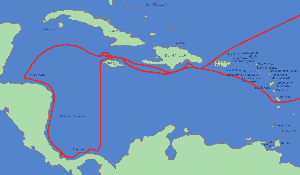
Nevertheless, Columbus made a fourth voyage. Accompanied by his brother Bartolomeo and his thirteen-year old son Fernando, Columbus left Spain on May 11, 1502. On June 15, they landed on the island of Martinique. A hurricane was brewing, so Columbus continued on, hoping to find shelter on Hispaniola. Columbus arrived at Santo Domingo on June 29, but was denied port.
After a brief stop at Jamaica, Columbus sailed to Central America, and explored the present-day coast of Honduras, Nicaragua, Costa Rica, and Panama. He established a garrison at the mouth of Rio Belen in January 1503, but one of the ships became stranded in the river and later the garrison was attacked. Returning to Hispanola, he ran into a storm which so severely damaged his ships that he had to beach them in a Jamaican bay. He was stranded. In a desperate effort to induce the natives to continue provisioning him and his hungry men, he successfully intimidated the natives by correctly predicting a lunar eclipse using astronomic tables. Help finally arrived on June 29, 1504, and Columbus and his men returned to Spain on November 7.
Later Life
While Columbus had always given the conversion of non-believers as one reason for his explorations, he grew increasingly religious in his later years. He claimed to hear divine voices, lobbied for a new crusade to capture Jerusalem, often wore a Franciscan habit, and described his explorations to the "paradise" as part of God's plan which would soon result in the Last Judgment and the end of the world.
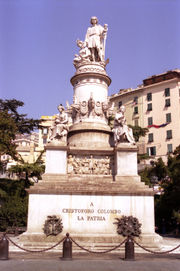
In his later years, Columbus demanded that the Spanish Crown give him 10 percent of all profits made in the new lands, pursuant to earlier agreements. Because he had been relieved of his duties as governor, the Crown felt not bound by these contracts and his demands were rejected. His family later sued for part of the profits from trade with America, but ultimately lost, some fifty years later. On May 20, 1506, Columbus died, still convinced that his journeys had been along the East Coast of Asia.
Perceptions of Columbus
The casting of Columbus as a figure of "good" or of "evil" often depends on whether people perceived the arrival of Europeans to the New World and the introduction of Christianity as positive or negative. In the United States and in many Latin American countries the day Columbus' expedition first sighted land, Columbus Day, is an official holiday. Hero worship of Columbus perhaps reached a zenith around 1892, the 400th anniversary of his first arrival in the Americas. Monuments to Columbus were erected throughout the United States and Latin America. More recently though, Columbus' legacy, has been viewed more harshly. The 500th anniversary of Columbus' first voyage was muted and often met by protest. In 2002 Venezuelan President Hugo Chavez signed a decree that changed "Columbus Day" to "The Day of Indigenous Resistance" and a few years later, protesters destroyed a 100-year old statue of Columbus in Caracas. However he is perceived, the historical importance of Columbus, his discoveries, and his explorations cannot be denied.
Cristóbal Colón y tres carabelas; la Niña, la Pinta y la Santa María zarparon el 3 de agosto de 1492.
Él navegó por primera vez a las Islas Canarias donde reaprovisionó e hizo reparaciones.
El 6 de septiembre, navegó hacia el oeste de nuevo.
Después de estar 29 días sin haber visto tierra, la tripulación detectó aves volando hacia el oeste y cambiaron su curso para seguirlos.
Luego, a las 2 am del 12 de octubre, un vigía gritó que había visto tierra.
La tripulación puso pie en una isla ese mismo día y Colón la nombró "San Salvador" a pesar de que los nativos la llamaban Guanahaní.
Los nativos americanos que habitaban las islas fueron descritos como "indios" por Colón, que creía que había descubierto Asia.
En realidad, había encontrado una isla en el Caribe.
Los nativos que Colón encontró, eran pacíficos y amistosos.
En las bitácoras escribió asombro de su inocencia amistosa y belleza
"Esas personas no tienen creencias religiosas y no veneran ídolos"
Ellos son muy bondadosos y no saben lo qué es la maldad
Ellos no matan a otros o roban
Ellos no tienen armas
No hubo derramamiento de sangre en ese primer viaje, sin embargo los isleños indígenas comenzaron a sucumbir a las enfermedades europeas desconocidas como la viruela, para las cuales no tenían inmunidad.
En ese primer viaje Colón también exploró la costa noreste de Cuba y la costa norte de La Española.
Fue aquí que la Santa María encalló y tuvo que ser abandonada.
Usando la madera del naufragio, Colón construyó un asentamiento y dejó 39 hombres.
El 4 de enero de 1493, se embarcó rumbo a casa.
Cuando se acercaba a las Azores, se topó con una de las peores tormentas del siglo.
Sorprendentemente, tanto la Niña como la Pinta se salvaron.
Saliendo de la isla de Santa María en las Azores, Colón desembarcó por primera vez en Portugal, y rapidamente se corrió la voz de sus descubrimientos por toda Europa.
Cuando por fin llegó a España, fue recibido como un héroe.
Este fue su más grande momento.
Él exhibió ante el tribunal a varios nativos secuestrados y lo que encontró de oro, así como la hasta entonces desconocida planta del tabaco,la piña, el pavo y la hamaca.
Una tierra redonda
Contrariamente a la creencia popular, la mayoría de la gente en el siglo 15 sabía que el mundo era redondo.
Esto fue cierto especialmente para los marineros, exploradores y navegantes.
Existía, sin embargo, la incertidumbre sobre el tamaño del mundo y su circunferencia.
Colón subestimó grandemente, el tamaño del mundo.
Cuando trató de financiar su expedición, primero se acercó a la corte de Portugal.
Fue rechazado, en parte porque los expertos del rey, que tenían una idea bastante precisa del tamaño del mundo, dudaban de que alguien pudiera sobrevivir el viaje de 19.600 kilometros (10.600 millas náuticas) desde Europa hasta Asia Oriental.
Tras el rechazo portugués, Colón trató de conseguir el apoyo de los monarcas españoles: Fernando de Aragón e Isabel I de Castilla.
Al casarse, Fernando e Isabel habían unido a los más grandes reinos de España y los estaban gobernando juntos.
Colón pasó los próximos 7 años presionando a la corte española, y en 1492 fue finalmente un éxito.
Los monarcas accedieron para ayudar a financiar la expedición.
Ya que España se agotó financieramente de la campaña para conquistar Granada; el último bastión musulmán en la Península Ibérica, el Tesoro Real tuvo que cambiar fondos entre distintas cuentas reales a fin de conseguir el dinero para la empresa de Colón.
Sólo la mitad del dinero provino de España.
Inversionistas italianos ya habían acordado proporcionar la mitad del dinero.
El segundo viaje
El 24 de septiembre de 1493, el almirante Colón partió de Cádiz, España, para su segundo viaje, con 17 barcos que transportaban suministros, y alrededor de 1200 hombres para ayudar en la subyugación de los nativos americanos y la colonización de la región.
El 3 de noviembre de 1493, Colón avistó una escarpada isla a la que llamó Dominica.
Navegando hacia el noroeste descubrió y exploró más de una docena de islas del Caribe antes de llegar finalmente a La Española y el lugar del asentamiento que comenzó.
Allí se encontró con que todos los colonos habían sido asesinados y la fortaleza quemada.
Antes de salir de España para su segundo viaje, había sido instruído por Fernando e Isabel, para mantener relaciones amistosas, incluso amorosas, con los nativos.
Sin embargo, durante su segundo viaje, envió una carta a los monarcas proponiéndoles esclavizar algunos de los pueblos nativos, especialmente los Caribes, con base en su agresividad.
A pesar de que su petición fue rechazada por la Corona, en febrero de 1495, Colón capturó 1600 Arawaks, una tribu pacífica, como esclavos.
Algunos de ellos fueron enviados a España, donde tras un procedimiento judicial, los supervivientes fueron puestos en libertad y se ordenó que fueran enviados a casa.
Algunos fueron retenidos por Colón y sus hombres como esclavos, mientras que los otros fueron dejados ir.
Ellos huyeron a las colinas, conviertiendose, de acuerdo a Colón, en futuros prospectos para su lúgubre captura.
El acorralar a los esclavos condujo a la primera gran batalla entre los españoles y los indios en el Nuevo Mundo.
El objetivo principal del viaje de Colón había sido el oro.
Para lograr esta meta, él impuso un sistema a los nativos de Haití.
Todos aquellos mayores de catorce años de edad tenían que encontrar una determinada cuota de oro.
Aquellos que fallaran en llegar a su cuota se les tendrían que cortar las manos.
A pesar de estas medidas extremas, Colón no logró obtener mucho oro.
En sus cartas al rey y la reina españoles, Colón sugirió repetidamente la esclavitud como una forma de sacar provecho de las nuevas colonias, pero estas sugerencias fueron rechazadas por los monarcas, quienes prefirieron ver a los nativos como futuros cristianos.
El tercer viaje
El 30 de mayo de 1498, Colón zarpó con seis barcos de Cádiz para su tercer viaje al Nuevo Mundo.
Colón desembarcó en la costa sur de la isla de Trinidad el 31 de julio.
Desde el 4 hasta el 12 agosto, exploró el golfo de Paria, que separa a Trinidad de Venezuela.
También exploró una pequeña parte de la parte continental de América del Sur, incluyendo el río Orinoco.
Inicialmente, él describió las nuevas tierras como pertenecientes a un nuevo continente hasta entonces desconocido, pero más tarde se retractó a su posición de que pertenecían a Asia.
Colón regresó a La Española el 19 de agosto para descubrir que muchos de los habitantes españoles de la nueva colonia estaban descontentos, después de haber sido engañados por Colón sobre las riquezas supuestamente generosas del nuevo mundo.
Colón tuvo que lidiar con colonos e indios rebeldes en repetidas ocasiones.
Él ahorcó a algunos de su tripulación por desobedecerlo.
Un número de colonos y frailes cabildearon en contra de Colón ante la corte española, acusándolo de malos manejos.
El Rey y la Reina enviaron al administrador real Francisco de Bobadilla en 1500, que, a su llegada, detuvo a Colón y sus hermanos y los había enviado a casa.
Colón se negó a que sus cadenas fueran quitadas en en el viaje a España, durante el cual escribió una larga carta de súplicas a los monarcas españoles.
A pesar de que recuperó su libertad, no recuperó su prestigio y perdió su cargo de Gobernador.
El cuarto y último viaje
Sin embargo, Colón hizo un cuarto viaje.
Acompañado por su hermano Bartolomé y su hijo de trece años de edad, Fernando, Colón salió de España el 11 de mayo de 1502.
El 15 de junio, desembarcaron en la isla de Martinica.
Un huracán se estaba gestando, por lo que Colón continuó, con la esperanza de encontrar un refugio en La Española.
Colón llegó a Santo Domingo el 29 de junio, pero se le negó el acceso al puerto.
Después de una breve parada en Jamaica, Colón navegó hacia América Central, y exploró la actual costa de Honduras, Nicaragua, Costa Rica y Panamá.
Él estableció una guarnición en la desembocadura del río Belén, en enero de 1503, pero uno de los barcos quedó varado en el río y más tarde la guarnición fue atacada.
De regreso a La Española, él se topó con una tormenta la cual daño gravemente las embarcaciones que tenia embarcadas en una bahía Jamaiquina.
Se quedó varado.
En un esfuerzo desesperado para inducir a los nativos para continuar aprovisionándolos a él y a sus hombres hambrientos, consiguió intimidar a los indígenas mediante la correcta predicción de un eclipse lunar el usando tablas astronómicas.
La ayuda por fin llegó el 29 de junio de 1504, y Colón y sus hombres regresaron a España el 7 de noviembre.
Vida Posterior
Mientras que Colón había argumentado siempre la conversión de los no creyentes como una de las razones para sus exploraciones, se volvió cada vez más religioso en sus últimos años.
Dijo escuchar voces divinas, cabildeó una nueva cruzada para capturar Jerusalén, a menudo llevaba un hábito franciscano, y describió sus exploraciones al "paraíso" como parte del plan de Dios que pronto se traduciría en el Juicio Final y el fin del mundo.
En sus últimos años, Colón exigió que la Corona Española le diera 10% de todos los beneficios obtenidos en las nuevas tierras, de conformidad con los acuerdos anteriores.
Debido a que había sido relevado de sus funciones como gobernador, la Corona sentía que no estaba obligada por estos contratos y sus demandas fueron rechazadas.
Su familia más tarde, los demandó por parte de los beneficios del comercio con América, pero perdió en última instancia, unos cincuenta años más tarde.
El 20 de mayo de 1506, Colón murió, aún convencido de que sus viajes habían sido a lo largo de la costa este de Asia.
Las percepciones de Colón
La imagen de Colón como figura de "bien" o "mal" a menudo depende de la percepción de la gente sobre la llegada de los europeos al nuevo mundo, y la introduccion del cristianismo como positivo o negativo.
En los Estados Unidos y en muchos países de América Latina el día que Colón avistó tierra por primera vez, "Día de Colón" (Descubrimiento de América/Día de la Raza), es un día feriado oficial.
La veneración de héroe hacia Colón alcanzó su máximo alrededor de 1892, en el 400 aniversrio de su primer arrivo a las Américas.
Monumentos a Colón se erigieron en los Estados Unidos y América Latina.
Más recientemente, sin embargo, el legado de Colón, ha sido visto con más dureza.
El 500 aniversario del primer viaje de Colón fue silenciado y, a menudo se encontrado por la protesta.
En 2002 el presidente venezolano Hugo Chávez firmó un decreto que cambió el "Día de Colón" (Descubrimiento de América/Día de la Raza)' a 'El Día de la Resistencia Indígena', y unos años más tarde, los manifestantes destruyeron una estatua de más de 100 años de Colón en Caracas.
Como sea que el sea percibido, la importancia histórica de Colón, sus descubrimientos y sus exploraciones no pueden ser negadas.
reprovision
aprovisionar de nuevo
spot
reconocer/ver
vigía
native
nativo
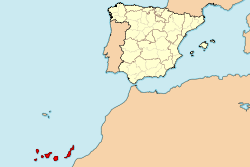
Canarias
inhabit
habitar
pacífico
log
diario/log
sentirse intimidado/sobrecogido por algn
idol
ídolo
dulce
derramar
sucumbir
indígena
islander
isleño
desconocido
viruela
inmunidad
run aground
encallar
maderas
naufragio
asentamiento
astoundingly
asombrosamente
spare
salvar
secuestrado
receive
recibir
tabaco
navigator
navegador
circunferencia
underestimate
subestimar
financiar
preciso
monarch
monarca
unite
unir
kingdom
reino
apoyo
lobby
vestíbulo
tesorero
royal
real
fortaleza
Granada
Península Ibérica
investor
inversor
fondos
cambiar
subyugación
fuerte
sight
avistar
esclavizar a
por motivos
petición
legal proceeding
procedimiento legal
release
liberar
prospect
perspectiva
oscuro
capture
capturar
round up
redondear
objetivo
viaje
objetivo
impose
imponer
cuota
chop off
cortar
esclavitud
Golfo de Paria
continente
descontento
abundante
tratar
hang
colgar
mala administración
administrador
detain
detener
shackle
argolla
suplicando
regain
recuperar
Gobernador
Sin embargo
accompany
acompañar
brew
infusión
de hoy en día
guarnición
establish
establecer
varado
playa
inducir
provision
disposición
intimidate
intimidar
eclipse lunar
astronomic table
tabla astronómica
conversión
non-believer
no creyente
Hábito franciscano
Juicio Final
de conformidad
relieve
aliviar
duty
deber
Corona
contract
contrato
sue
demandar
cast
emitir
sight land
avistar tierra
cenit
monument
monumento
erect
erigir
legado
duramente
apagado
decreto
protesta
protester
manifestante
perceive
percibir
obligado
demand
demanda
al final
predict
predecir






